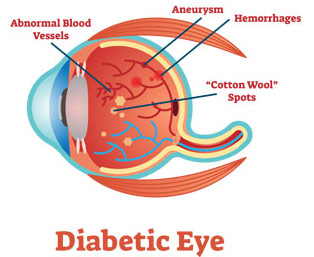If you have diabetes mellitus, your body does not use and store glucose properly.
Over time, diabetes can damage blood vessels in the retina (the inner layer of tissue that lines the back of the eye). The retina is composed of a network of nerves that sense light and help to send images to the brain.
The damage to retinal blood vessels is referred to as diabetic retinopathy.
Diabetic retinopathy can arise when you have diabetes mellitus.
If you have diabetes mellitus, your body does not use and store glucose properly.
Over time, diabetes can damage blood vessels in the retina (the inner layer of tissue that lines the back of the eye). The retina is composed of a network of nerves that senses light and helps to send images to the brain.
If you have diabetes, early detection of diabetic retinopathy is the best protection against loss of vision.
You can significantly lower your risk of vision loss by maintaining strict control of your blood glucose and visiting your ophthalmologist regularly.
People with diabetes should schedule examinations at least once a year.
Pregnant women with diabetes should schedule an appointment in their first trimester, because retinopathy can progress quickly during pregnancy.
People with diabetic retinopathy may have few symptoms until it is very advanced and difficult to treat.
To prevent progression of diabetic retinopathy, people with diabetes should control their levels of blood sugar, blood pressure and cholesterol. There is considerable evidence to suggest that rigorous control of blood sugar decreases the chance of developing serious proliferative diabetic retinopathy.
A medical eye examination is the only way to discover any changes inside your eye.
If the eye examination finds diabetic retinopathy, you may require a special test called fluorescein angiography or optical coherence tomography (OCT) to find out if you need treatment.
More frequent medical eye examinations may be necessary after a diagnosis of diabetic retinopathy.
During the first stages of diabetic retinopathy, no treatment is needed, unless you have macular edema.
Once you have advanced stages of diabetic retinopathy, there may be certain treatments to improve your vision.


